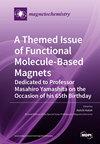Temperature Dependence of Magnetization Dynamics in Co/IrMn and Co/FeMn Exchange Biased Structures
IF 2.5
4区 化学
Q2 CHEMISTRY, INORGANIC & NUCLEAR
引用次数: 0
Abstract
Thin film ferromagnet/antiferromagnet (F/AF) exchange biased structures that are widely used in GMR spin valves are considered nowadays as promising systems for antiferromagnetic spintronic and spin-orbitronic devices. Here, the temperature dependences of magnetization dynamics in Co/IrMn and Co/FeMn F/AF structures are investigated using ferromagnetic resonance (FMR) in comparison to a free Co layer. A strong additional decrease in the resonance field was observed in Co/IrMn with a temperature decrease attributed to the rotatable anisotropy increase, which almost vanished at room temperature. In contrast to Co/IrMn, the contribution of the rotatable anisotropy in Co/FeMn is much weaker, even though it exists at RT, it is negative, and slightly varies with the temperature and resonance field shift in Co/FeMn. This is mainly due to unidirectional exchange anisotropy. FMR linewidth for the free Co layer increases with decreasing temperature and is accompanied with a slow relaxation process, while the additional contribution to FMR line broadening in Co/IrMn and Co/FeMn structures is correlated with variation in the exchange anisotropy. The observed results are discussed based on structural and surface morphology and magnetization reversal characterization using X-ray diffraction, atomic force microscopy, and vibrating sample magnetometry data.Co/IrMn和Co/FeMn交换偏置结构磁化动力学的温度依赖性
薄膜铁磁体/反铁磁体(F/AF)交换偏置结构广泛应用于GMR自旋阀中,目前被认为是反铁磁自旋电子和自旋轨道电子器件的有前途的体系。本文利用铁磁共振(FMR)研究了Co/IrMn和Co/FeMn F/AF结构中磁化动力学的温度依赖性,并与自由Co层进行了比较。在Co/IrMn中,由于可旋转各向异性的增加,随着温度的降低,共振场出现了强烈的附加减小,在室温下几乎消失。与Co/IrMn相比,Co/FeMn中可旋转各向异性的贡献要弱得多,即使在室温下存在,但它是负的,并且Co/FeMn中随温度和共振场位移的变化很小。这主要是由于单向交换的各向异性。自由Co层的FMR线宽随温度的降低而增加,并伴随一个缓慢的弛豫过程,而Co/IrMn和Co/FeMn结构中FMR线宽的额外贡献与交换各向异性的变化有关。利用x射线衍射、原子力显微镜和振动样品磁强计数据对观察到的结果进行了结构和表面形貌以及磁化反转表征。
本文章由计算机程序翻译,如有差异,请以英文原文为准。
求助全文
约1分钟内获得全文
求助全文
来源期刊

Magnetochemistry
Chemistry-Chemistry (miscellaneous)
CiteScore
3.90
自引率
11.10%
发文量
145
审稿时长
11 weeks
期刊介绍:
Magnetochemistry (ISSN 2312-7481) is a unique international, scientific open access journal on molecular magnetism, the relationship between chemical structure and magnetism and magnetic materials. Magnetochemistry publishes research articles, short communications and reviews. Our aim is to encourage scientists to publish their experimental and theoretical results in as much detail as possible. Therefore, there is no restriction on the length of the papers. The full experimental details must be provided so that the results can be reproduced.
 求助内容:
求助内容: 应助结果提醒方式:
应助结果提醒方式:


